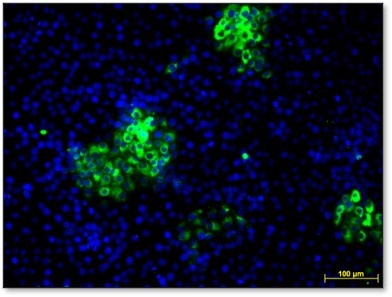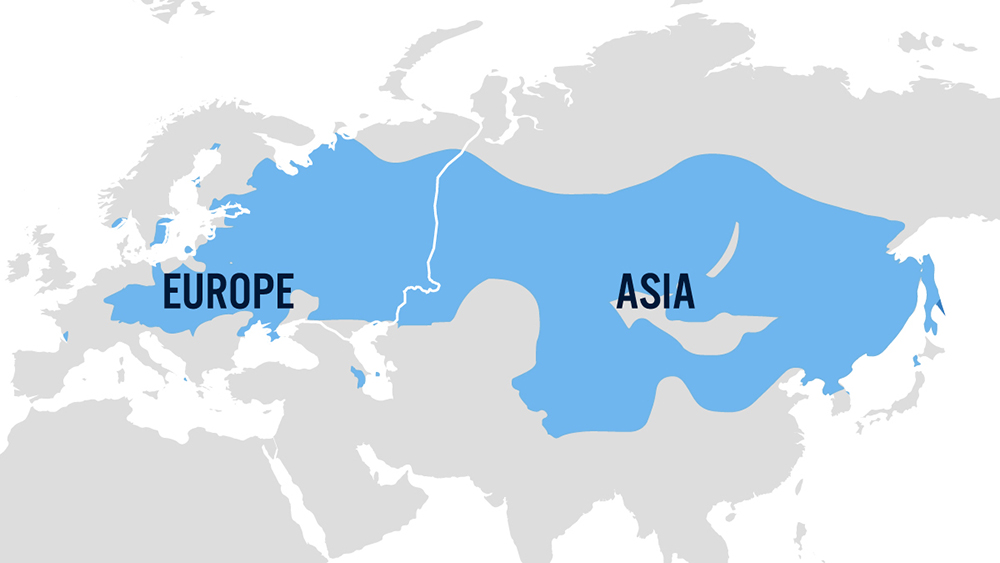Tick-borne encephalitis virus
Tick-borne encephalitis (TBE) is a viral infection, which may affect the central nervous system. The disease may be fatal in some cases. A vaccine is available for protection against the disease.
Pathogen

Tick-borne encephalitis (TBE) is caused by a virus of the genus Flavivirus within the Flaviviridae family. The genus Flavivirus comprises more than 70 different species. Many of these species are important human pathogens, and most of them are transmitted by the bite of an infected arthropod (tick or mosquito). Dengue virus, Japanese Encephalitis Virus, Yellow Fever virus, and Zika virus are other well-known members of the genus Flavivirus.
There are three well-known subtypes of the virus, which are phylogenetically highly related. In Switzerland, the European subtype of the virus, transmitted by the tick species Ixodes ricinus, is circulating. The Far Eastern and Siberian subtypes are found in Europe in the Baltic area and the coast of Finland as well as in Asia, and are transmitted by the tick species Ixodes persulcatus.
Epidemiology
Ticks vectoring the virus are found in many european countries, in Russia and in Asia. In many countries, TBE is a notifiable disease; up to 12’000 disease cases are annually reported in these countries. In Switzerland, numbers of reported disease cases have fluctuated between 100 and 250 cases per year since 2005. During the past few years, however, case numbers have increased (2020: 455 cases), the causes of which are diverse and not yet completely understood. Maps showing the regions of registered tick bite sites and recommendations for TBE vaccination are available.
In nature, tick-borne encephalitis virus (TBEV) circulates in so-called natural foci (5’000-10’000m2) in cycles involving ticks and wild animals.
Besides these foci, ticks are free of the virus. Generally, prevalence of infected I. ricinus ticks within the natural foci is relatively low; in Switzerland, it is about 0.5 %. The persistence of a natural focus depends on a sufficient transmission between ticks and reservoir hosts. Natural TBEV reservoir hosts are rodents, foxes, martens, hedgehogs, and moles.
In most cases, virus transmission occurs by the bite of an infected tick. However, in rare cases, alimentary transmission via the consumption of non-pasteurized (cow, sheep, exceptionally cow) milk or milk products is possible.
Clinical manifestation
The infection is thought to be asymptomatic or subclinical in approximately 75 – 95% of individuals infected with TBEV. When additionally taking into account the virus prevalence in ticks, about 1 – 2% of individuals being bitten by a tick in an endemic region will develop symptomatic disease.
Infections with the European subtype of the virus typically take a biphasic course. After an incubation period of 1 – 10 days, flu-like symptoms occur as a consequence of primary viraemia. This initial phase is followed by an asymptomatic interval of about 1 – 10 days. In about one third of cases, disease then progresses to its neurological stage. Progression of this second disease stage is classified as mild, moderate or severe, depending on which part of the central nervous system is affected. Meningitis (in Switzerland 22% of all cases with neurological involvement) manifests with headache, nausea, vomiting, vertigo, and neck stiffness. Meningoencephalitis (55%) is associated wiht cerebellar symptoms, typically disturbances in motion coordination and impaired consciousness, which can range from drowsiness to coma. Meningoencephalomyelitis (3%) manifests with flaccid paralysis of the arms, back, or legs, with the upper extremities more commonly affected than the lower. Prognosis is poor when the medulla oblongata and central brainstem are affected. Approximately 1 – 2% of patients die from TBE.
Therapy
There is no specific treatment against TBE, treatment is symptomatic. The potential of some antiviral substances, immunoglobulins and other protective substances is being evaluated.
Vaccination
There exists an efficient and safe vaccination against TBE. Vaccination is recommended to all individuals (generally from the age of 6), who get exposed to tick bites in a risk area. Basic immunization comprises 3 vaccine doses. Booster vaccination is required every 10 years when the risk of exposure persists.
Diagnostics

As the clinical symptoms and laboratory parameters generally do not differ from those of other central nervous system diseases, diagnosis has to be established with specific laboratory tests. In theory, direct detection of viral RNA is possible from blood samples taken during the first phase of the disease using polymerase chain reaction PCR. During the second phase, viral RNA is generally no longer detectable, neither in the blood nor in the cerebrospinal fluid, due to evolving immune response. As affected individuals usually do not search medical help until the onset of neurological symptoms during the second phase of the disease, direct detection methods are of secondary importance. ADMED Microbiologie nevertheless provides this method for specific questions.
Serology is the method of choice for detecting infections with TBEV.
In the majority of patients with neurological symptoms, specific IgM and IgG antibodies are detectable in the first serum sample. Interpretation of serological tests is complicated by the pronounced cross-reactivity (especially for IgG antibodies) with other flaviviruses (e.g. Yellow Fever virus, Dengue virus, Japanese encephalitis virus; also upon vaccination against these viruses). Virus-binding but not neutralizing antibodies produce false-positive results in ELISA tests routinely used in diagnostic laboratories. Discrimination of virus-neutralizing antibodies requires a serum neutralization test; this test is performed at the CHUV, Laboratoire de Microbiologie.
Sources
- Robert Koch Institute, guide to tick-borne encephalitis
- Federal Office for Public Health Switzerland, information on TBE
- Dobler G. et al, The TBE Book, 4th Edition, Global Health Press 2021
- BAG Bulletin 41, 2016
- Holzmann H; Diagnosis of tick-borne encephalitis. Vaccine 21 (2003) S1/36-S1/40
- https://www.zecken.de
- https://zecken-stich.ch

